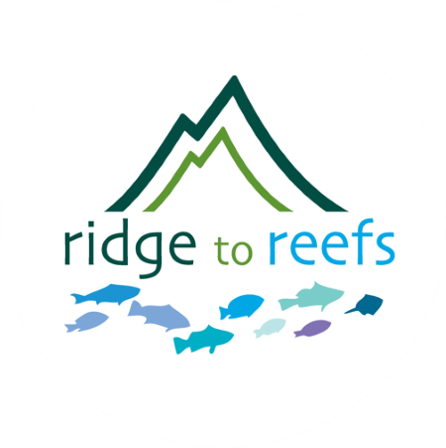
Resources
Concepts & Terms
Simply put, urban agriculture is cultivating plant growth, including food and natural medicinal plants, within urban landscapes. Doing this creates a series of critical impacts that support social and environmental justice. Read more about urban agriculture.
Learn about solutions to the threats facing the ocean today, and how Ridge to Reefs and our partners are working to build ocean health. Read more about ocean conservation.
Wood Chip Bioreactors
A wood chip bioreactor is designed to treat runoff water, drainage ditches, or ponds. The main component of a wood chip bioreactor is a buried trench filled with wood chips. Water is diverted to the wood chip trench. The trench provides the proper environment (carbon from wood chips, nitrate-nitrogen from agricultural drainage, and low dissolved oxygen) to promote the denitrifying process that converts nitrates to harmless nitrogen gas, which makes up 78% of the air we breathe. Water quality data shows that this innovative technology is highly effective at reducing nitrate with a greater than 90% removal rate. Read more about wood chip bioreactors here.
Biochar is a type of charcoal produced by burning plant material under very low oxygen conditions. Biochar improves soil quality, increases water retention and enhances microorganism diversity, making soils more fertile and hospitable for plants and other beneficial organisms. Ridge to Reefs uses biochar in green infrastructure wastewater treatment systems and agricultural applications. Biochar improves soil health due to its high carbon content, ability to uptake heavy metals, and soil pH balancing effects. Read more about biochar.
Vetiver grass is resilient grass that thrives in a wide range of soil types and climates. It can be propagated such that it does not produce any seeds; its growth can be controlled within a closed system.
Vetiver grass is a natural and effective method of wastewater treatment since it grows rapidly and has extensive root systems. Vetiver grass is also effective as a "sediment trap" when planted along the contour of eroding slopes. Read more about vetiver grass.
High nutrient concentrations are greatly reduced by natural processes as they flow downstream through wetlands. The intact ecological functions of wetlands buffer areas from flooding, slow the movement of water, and allow for natural filtration. Restored and created wetlands that work in concert with the local environment have similar benefits. Wetlands can be designed to target agricultural areas and other sources of nutrient runoff. These healthy wetlands restore ecological function and improve water quality downstream. Read more about treatment wetlands.
Rain Garden & Rain Barrels
Rain gardens filled with native plants capture rain water and allow for natural filtration of sediment and pollutants that would otherwise wash into the watershed downstream. Rain barrels catch otherwise wasted stormwater and allow for sustainable uses from garden irrigation to car washing without any additional energy or water expenditure. Read more about low impact development strategies.
Action Areas
Sustainable Agriculture improves food and economic security, community health and wellness, water quality, soil health, and carbon sequestration. Ridge to Reefs works with farmers to promote sustainable agriculture using both traditional methods and innovative technology. Read more.
Watershed Restoration restores the original function of degraded ecosystems. Ridge to Reefs restores upstream ecosystems and wetlands in order to protect downstream ecosystems, such as coral reefs and mangroves, from toxics, nutrients and sediment loads. We also establish green infrastructure solutions such as constructed wetlands, rain gardens, and bioreactors to treat polluted storm and wastewater. Read more.
Clean Water is an essential component of restoring environmental function. Pollution and lack of intact waste management structures creates a cascade of environmental problems, including threats to human health, stressors on native wildlife, and the degradation of downstream ecosystems. Ridge to Reefs works on cleaning water through local direct interventions. These interventions include development and implementation of water treatment systems that work with the natural landscape, organizing large-scale clean-up efforts, and supporting sustainable business and farming practices. Read more.
Social Resilience is an essential component of lasting environmental and economic sustainability. Protection of natural resources goes hand-in-hand with a sustainable local economy. Ridge to Reefs focuses on local partnerships to create longevity in all our program efforts. We establish collaborative partnerships to create mechanisms for maintenance and long-term sustainability of restoration sites and practices. We work with local policy makers and create engagement between governments, agencies, educational institutions, and stakeholders around restoration and environmental protection activities. We also support the establishment of local sustainable businesses and microentrepreneurship. Read more.
General Terms
Watershed
Rain falls onto the land, condensation forms, and snow melts. Water that does not evaporate and is not absorbed runs from the land with gravity, flowing downhill and collecting in creeks, streams, rivers, and lakes. Every body of water has a watershed, and these bodies of water flow together forming large rivers, bays, and oceans. Watersheds are often treated as management units, but they are all interconnected.
Green Infrastructure
Natural structures frequently provide important benefits to human communities. Mangroves, wetlands, and reefs buffer storms, vegetation holds soils in place and prevents erosion, porous surfaces help absorb water and slow runoff; the benefits are numerous. These natural structures are called green infrastructure in light of their direct benefits to human communities. Specific functions can be achieved by planning, developing, and restoring areas of green infrastructure.
Wetland
Some areas of land are inundated with water tidally or seasonally. Wetland plants are specifically adapted to different levels of water saturation, and many species rely on wetlands for habitat.
Wetlands provide critical functions filtering water, absorbing excess nutrients, and providing inland areas a physical buffer from storms and strong waves.
















